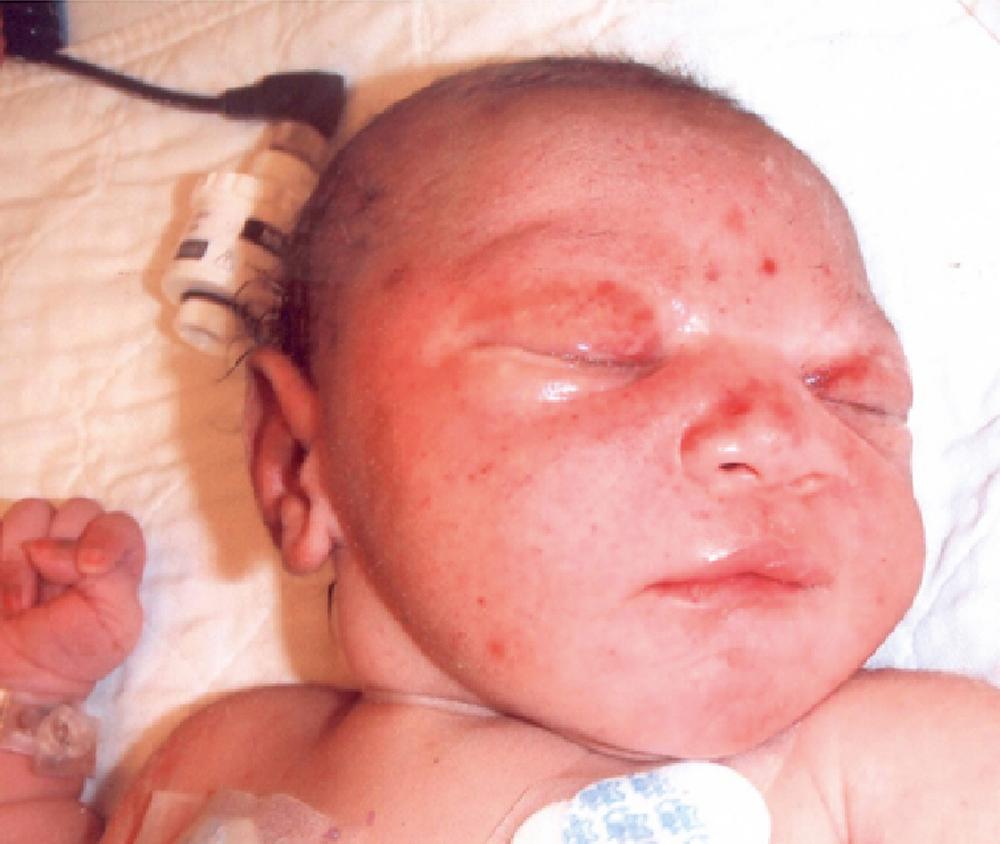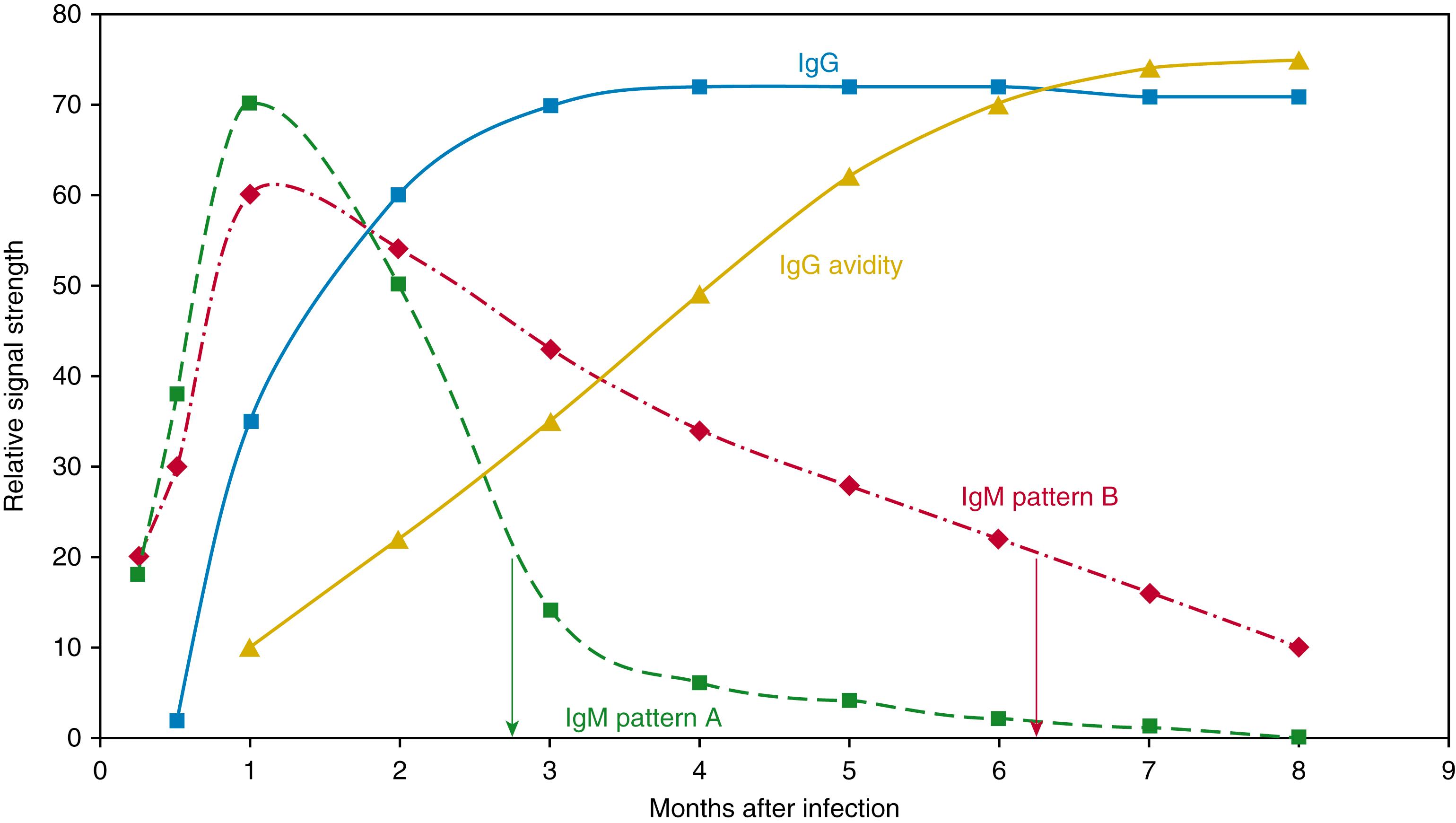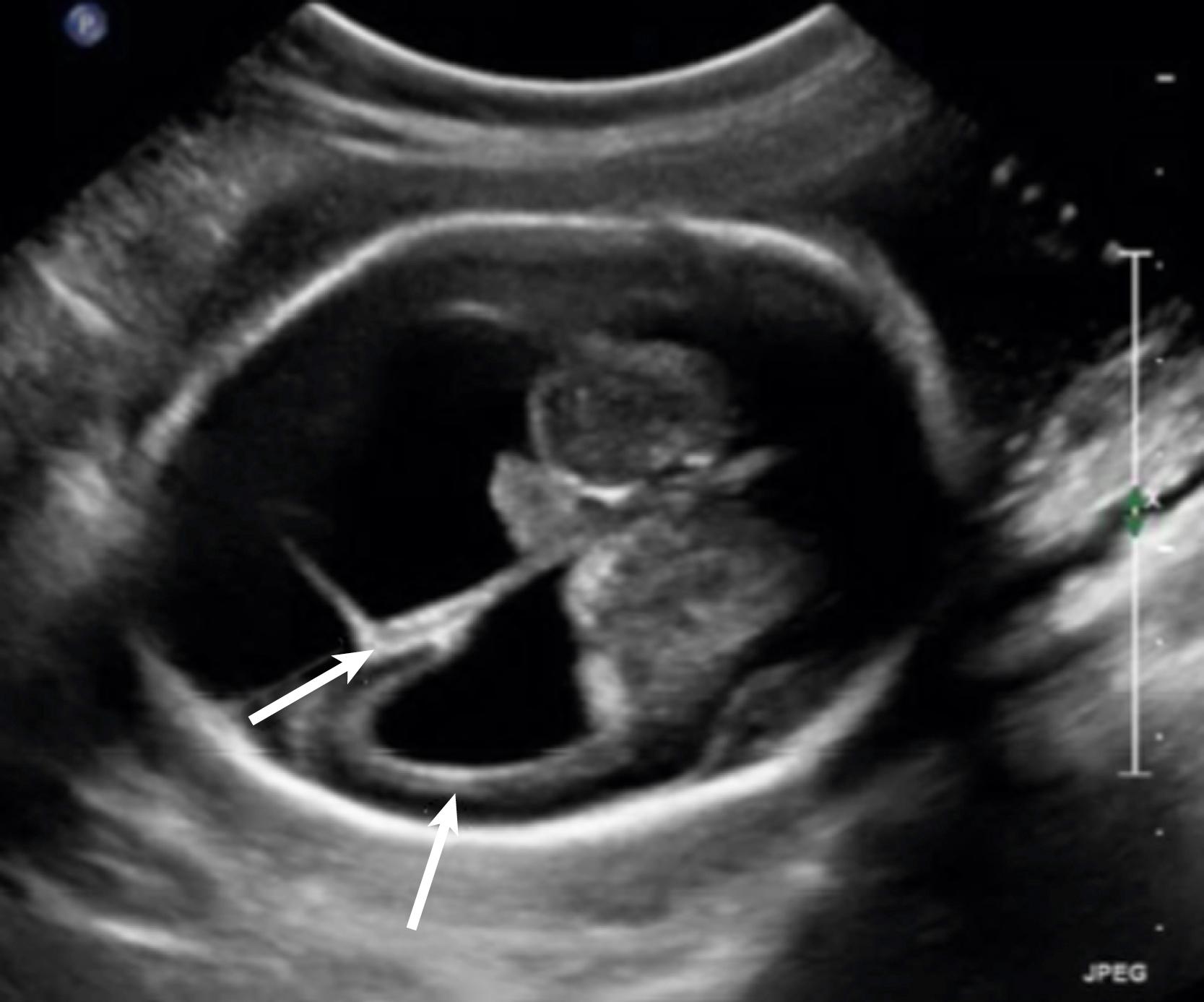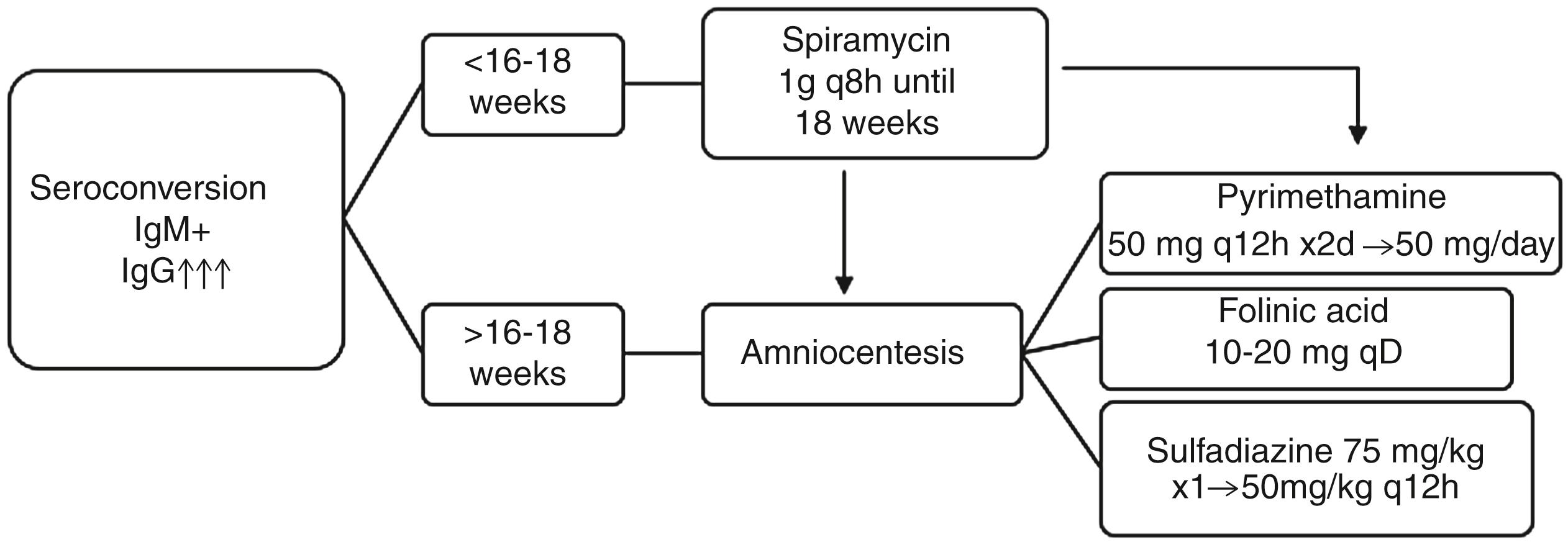Physical Address
304 North Cardinal St.
Dorchester Center, MA 02124
Select infections during pregnancy carry risks to pregnant individuals, the pregnancy itself, the fetus, and the neonate. The term TORCH, ( t oxoplasmosis, o ther, r ubella, c ytomegalovirus, h erpes simplex virus) was coined in 1971 to categorize pathogens that can traverse the maternal-fetal interface and cause clinical congenital malformations. These pathogens display remarkable heterogeneity in transmission efficacy and presentation ( Table 51.1 ). Some infections are largely teratogenic, suggesting that the fetal inflammatory response and direct pathogen-mediated damage disrupts fetal development (e.g., cytomegalovirus, Zika virus). In contrast, other pathogens cause significant disease at the maternal-fetal interface (e.g., group B Streptococcus [GBS], L isteria monocytogenes ) and have profound effects on placental nutrient exchange, causing stillbirth and preterm labor. The pathogen-host interactions are complex, and placental immune defenses play a key role in limiting transmission of these infections at this crucial interface. As such, vertical transmission only occurs in a subset of cases for any of these diverse pathogens. In this chapter we will review common infections that can cause morbidity to the maternal-fetal dyad including cytomegalovirus , Toxoplasma gondii , Zika virus, rubella, parvovirus B19, L . monocytogenes , and group B Streptococcus . Other infections that have been shown to have the ability to be vertically transmitted include E. coli , hepatitis B and C, HIV, varicella zoster virus, malaria, Chagas disease, and some emerging pathogens including Ebola, West Nile virus, and Rift Valley fever. These are reviewed elsewhere in chapters on bacterial and viral pathogens in pregnancy and in references .
| Pathogen | Classification | Mode of Maternal Transmission | Mode of Fetal/Neonatal Transmission | Hallmarks of Congenital Infection |
|---|---|---|---|---|
| L. monocytogenes | Bacterial | Contaminated food | Placental contamination with parturition |
Stillbirth/pregnancy loss Preterm delivery Neonatal sepsis |
| S. agalactiae (GBS) | Bacterial | Commensal | Ascending infection Contamination with parturition |
Neonatal sepsis |
| E. coli | Bacterial | Commensal | Ascending infection Contamination with parturition |
Neonatal sepsis |
| T. pallidum | Bacterial | Sexual | Transplacental | Stillbirth/pregnancy loss Low birth weight Hepatosplenomegaly Saddle nose deformity Rhinitis Dental deformities Chorioretinitis Rash Dilated bowel Skin thickening Periostitis, bone fractures, and demineralization |
| Cytomegalovirus | Viral | Ingestion of contaminated fluids | Transplacental Breastfeeding (less common) |
Hearing loss Low birth weight Chorioretinitis Developmental delay Anemia/thrombocytopenia Rash Stillbirth/pregnancy loss Ventriculomegaly Intracerebral calcification Echogenic bowel/abdominal calcifications |
| HSV-1/HSV-2 | Viral | Sexual or oral contact | Transplacental viral shedding with parturition | Parturition: Neonatal meningitis Transplacental: Dermatologic lesions Ventriculomegaly Microcephaly Intracerebral calcifications Chorioretinitis Optic atrophy Limb dysplasia |
| Zika virus | Viral | Arbovirus: Aedes species, sexual, blood-borne | Transplacental Possible ascending |
Microcephaly FGR Hepatosplenomegaly Intrahepatic calcifications Ventriculomegaly Intracerebral calcifications Echogenic bowel Stillbirth/pregnancy loss |
| Parvovirus B19 | Viral | Respiratory droplets | Transplacental | Anemia Hydrops Stillbirth/pregnancy loss |
| T. gondii | Parasitic | Ingestion of contaminated food or oocytes | Transplacental | Ventriculomegaly Hydrocephalus Intracerebral calcifications Choroid plexus cysts Hydrocephalus Ascites FGR Hepatosplenomegaly |
| P. falciparum P. vivax |
Parasitic | Arthropod vector | Placental | FGR Preterm delivery Severe hypoglycemia |
| T. cruzi | Parasitic | Arthropod vector | Transplacental | Symptomatic at birth: FGR Respiratory failure Hepatosplenomegaly Meningitis Heart failure Hydrops Asymptomatic at birth: Chronic Chagas disease |
Cytomegalovirus (CMV) is a DNA virus and a member of the herpesvirus family. Like other members of this family, CMV remains latent in host cells after the initial infection and can reactivate to cause recurrent viremia. The majority of infections in pregnancy are caused by virus reinfection/reactivation, but primary infection causes more severe congenital disease. CMV is the most common cause of congenital hearing loss and is the most common cause of infection-mediated birth defects, affecting approximately 1% of live births in the United States.
CMV is transmitted through contact with infected body fluids (breastmilk, urine, saliva, fecal material, genital tract secretions), transplantation (organ or blood transfusion), or vertically. There remains substantial geographic and socioeconomic variation in infection and immunity. Risk factors for seroconversion include working with children (e.g., daycare workers, teachers), young age, recent sexual debut, geography, immunosuppression, and transplant recipients.
Congenital CMV is the most common congenitally acquired infection in the United States and is underappreciated globally as a significant cause of neonatal morbidity. , Congenital infection is primarily thought to be transplacental, but infection through genital tract secretions with vaginal delivery and via breastmilk has also been reported. Transmission is likely dependent on viremia, and primary infection has a higher rate of vertical transmission than reinfection or reactivation. A wide variety of interventions have been studied to prevent morbidity from congenital CMV infection including IVIG and valganciclovir, and none have been proven to be efficacious (see Treatment section later).
CMV infection classically presents in childhood. Matrenal risks of acquiring infection increase in patients who have frequent contact with children. Maternal infection is asymptomatic to mild and suggestive of a flulike illness. Rarely CMV infection in adults can be more severe and can include fevers, hepatosplenomegaly, lymphadenopathy, and substantial laboratory abnormalities (transaminitis, pancytopenia). In immunosuppressed or transplant patients CMV can cause life-threatening systemic illness, hepatitis, pneumonia, and chorioretinitis, so transplant donors and recipients are tested for CMV infection.
Because the maternal clinical presentation is often subclinical, the clinical finding of an affected fetus or neonate may be the first identification of CMV infection. CMV is a teratogen, and vertical transmission can cause a wide variety of sequelae. Congenital infection is classified into symptomatic and asymptomatic ( Table 51.2 ). Symptomatic congenital CMV infection has a broad range of clinical symptoms ranging from congenital hearing loss to microcephaly and severe developmental delay. If findings of CMV are present on prenatal ultrasound, a careful search for additional anomalies is warranted, as approximately half have multiple abnormalities. , Ventriculomegaly is present in 50%–80% of symptomatic cases and can be mild to severe. , Intracranial findings secondary to hemorrhage or germinal matrix necrosis can also be seen in CMV: pseudocysts, calcifications, and intraventricular synechiae. Abnormal cortical development, callosal dysgenesis, schizencephaly, and abnormally developed sulci can be seen with infection in early pregnancy. In addition to the neurologic findings, CMV is associated with echogenic bowel, fetal growth restriction, hepatomegaly, splenomegaly, and placentomegaly ( Fig. 51.1 ). Rarely hydrops and stillbirth can occur. Of note, there is substantial overlap in ultrasound findings with other TORCH pathogens, and ultrasound is not diagnostic for any individual infection ( Table 51.1 ).
| Asymptomatic Cytomegalovirus | Symptomatic Cytomegalovirus |
|---|---|
| No ultrasound or neonatal exam findings | Ultrasound and/or neonatal findings |
| 80%–90% of infections | 10%–15% of infections |
| 10%–15% develop hearing loss | 25% of primary infections |

Congenital CMV infection is often asymptomatic with normal antenatal ultrasounds and a normal postnatal exam ( Table 51.2 ). Asymptomatic CMV infection is associated with longer term neurologic sequelae and hearing loss. In the event of confirmed CMV infection in pregnancy, pediatric infectious disease consultation is recommended to establish care and close follow-up.
Approximately 50%–70% of adults demonstrate evidence of prior infection, and serologies can be useful for information regarding fetal risk (see below). , Reactivation of latent virus or reinfection with a new strain can also cause disease and are indistinguishable by serologies. Reactivation/reinfection leads to vertical transmission in approximately 0.5%–1% of cases, but causes the majority of congenital cases given its much higher prevalence. , In contrast, primary infection has vertical transmission rates of approximately 20%–50%. There remains substantial variation in transmission with advancing gestation, with higher levels of transmission in the 3rd trimester. Substantially more symptomatic and severe congenital disease occurs with primary infection in the periconception period and in the first trimester. Approximately 5% to 15% of congenital CMV infections resulting from primary maternal infection in the first half of pregnancy are symptomatic at birth: 30% of severely infected infants die, and 80% of survivors have major morbidity. Among the 85% to 90% of infants with congenital CMV infection who are asymptomatic at birth, 10% to 20% subsequently develop hearing loss, chorioretinitis, motor, or sensory delays.
The molecular pathogenesis of the virus’ effects is not well understood. Determinants of vertical infection are not well known, and in vitro and in vivo studies are technically challenging. The decidua has been shown to be permissive to infection, and may serve as a reservoir, but the syncytiotrophoblast displays gestational-age-specific variable resistance to infection with multiple pathways that inhibit viral transmission and replication. , Placental pericytes are also permissive to infection and may be a mechanism of transplacental transportation. Ultrasound findings present in congenital CMV (see above) are suggestive of a fetal inflammatory response to the virus that may contribute to teratogenic potential.
Universal screening in pregnancy is not currently recommended for CMV. Despite the wide variety of sonographic findings, ultrasound is a poor screening tool for congenital CMV. Screening for exposure history and risk assessment after identification of a sonographic abnormality is recommended as part of the workup for suspected fetal growth restriction, ventriculomegaly, and echogenic bowel. Exposure history and risk factor assessment are important to ascertain for adequate screening for additional diagnostic evaluation.
The gold standard for diagnosis of CMV infection is confirmation by viral culture or PCR in body fluids. The highest concentrations of virus are in plasma, urine, seminal fluid, saliva, and breast milk, with most cultures becoming positive within 72 to 96 hours of onset of infection. Viremia is consistent with acute infection, although it can still occur with recurrence or reactivation. In the setting of known maternal primary infection, fetal infection can be confirmed. The most sensitive and specific test for diagnosis of fetal infection is PCR from amniotic fluid. Both ultrasound and viral detection are used in diagnosis of congenital CMV, but neither are completely predictive for severity of postnatal sequelae and pediatric infectious disease follow-up is recommended.
Serologic methods also are valuable in the diagnosis of CMV infection. Approximately 50% to 80% of adult women in the United States have serologic evidence of past CMV infection. There is no single immunoglobulin G (IgG) titer that clearly differentiates acute from recurrent infection or reactivation. However, a fourfold or greater change in the IgG titer over 2 weeks usually is consistent with recent acute infection. In the setting where IgM and IgG are positive, IgG avidity can be useful to diagnose primary infection as well. Positive IgM titers usually decline rapidly over a period of 30 to 60 days, but they can remain elevated for as long as 12 months. Low- to moderate-avidity IgG antibody, combined with the presence of IgM antibody, is consistent with primary infection. If high-avidity IgG antibody is present, the patient typically has a history of infection over 6 months ago or there is a recurrent infection ( Fig. 51.2 ). Serum IgM can be elevated with reactivation but is not diagnostic. Moreover, IgG avidity has only been validated in patients with positive IgG and IgM serologies to CMV. Avidity should not be sent if IgG is positive alone in the absence of IgM.

Unfortunately, there are no proven effective therapies for congenital CMV infection. Several cohort studies initially described benefit from CMV-specific intravenous hyperimmune globulin (CytoGam™) as treatment and prophylaxis for congenital CMV infection. , These studies led to a larger randomized control trial coordinated through the Eunice Kennedy Shriver National Institute of Child Health and Human Development (NICHD) Maternal-Fetal Medicine Units Network on the utility of hyperimmune globulin therapy to treat proven congenital CMV. The study was discontinued early due to clinical utility and clinical efficacy not being demonstrated on interim evaluation. The trial demonstrated that hyperimmune globulin had no effect on neonatal or congenital outcomes.
Using a different approach, several cohort studies have suggested high-dose valacyclovir may have clinical utility. , Most recently, De Santis and coworkers followed this up with a case series of valacyclovir use in 12 women with diagnosis of primary CMV infection by serology and exposure. Treatment was discontinued if an amniocentesis was negative. A portion of fetuses converted post the initial amniocentesis after valacyclovir was discontinued, but no infants were symptomatic at birth. The success of this very small number of subjects has led some to suggest that off-label observational use could be considered, but this is not endorsed by any of the major society guidelines at this time.
Preventive measures should be employed to ensure that women do not contract CMV during pregnancy. Patients should be encouraged to use careful hand washing techniques after handling infants’ diapers and children’s toys. Safe sex practices should be encouraged. CMV-negative blood products should be used when transfusing pregnant women or fetuses.
Toxoplasma gondii is a protozoan that has three distinct life forms: trophozoite, cyst, and oocyst. The life cycle of this organism is dependent on wild and domestic cats, which are the only known host for the oocyst. The oocyst is formed in the intestine of the cat and subsequently is excreted in feces. Mammals then inadvertently ingest the oocyst, which is disrupted in the animal’s intestine, releasing the invasive trophozoite. The trophozoite then is disseminated throughout the body, ultimately forming cysts in brain and muscle. Feral cats and outdoor domestic cats that may eat raw meat are most likely to carry the parasite. Human infection occurs when infected meat is ingested, or the feline fecal oocysts are ingested. Importantly, the oocyst is destroyed by proper cooking of meat. Infection rates are elevated in areas of poor sanitation and crowded living conditions.
Most infections in humans are asymptomatic. However, even in the absence of symptoms, patients may have evidence of multiorgan involvement, and clinically apparent disease can develop after a long period of asymptomatic infection. Symptomatic toxoplasmosis typically presents with cervical and generalized lymphadenopathy with possible fever similar to mononucleosis syndrome. In contrast to infection in the immunocompetent host, toxoplasmosis can be a devastating infection in the immunosuppressed, causing encephalitis, meningoencephalitis, and intracerebral abscess. Pneumonitis, myocarditis, and chorioretinitis also occur.
Congenital infection can have a wide range of clinical presentations, but typically presents with abnormal neurologic findings noted on ultrasound. Codaccioni and colleagues reported a contemporary evaluation of 88 cases of congenital toxoplasmosis. Just over half, 45 of 88, had CNS anomalies, and 39% had ultrasound findings of both extracerebral and neurologic anomalies. The most common extracerebral findings included hepatomegaly, splenomegaly, placentomegaly, growth restriction, ascites, and echogenic bowel ( Table 51.3 ). The most common cerebral abnormalities included intracranial echogenic foci, ventriculomegaly, intracranial cysts, and periventricular echogenicities ( Fig. 51.3 ).
| Location of Findings | Frequency | Intracerebral Findings | Extracerebral Findings |
|---|---|---|---|
| Intracerebral only | 51.1% | Intracranial hyperechogenic nodular foci (73%) Ventriculomegaly (46%) Periventricular abscess Periventricular echogenicities Lenticulostriate vasculitis (candelabra sign) |
None |
| Intracerebral and systemic | 39.8% | Intracranial hyperechogenic nodular foci (57%) Ventriculomegaly Periventricular echogenicities Delayed gyration Cerebellar hypoplasia Cataracts |
Fetal growth restriction Placentomegaly (28%) Hydrops Hepatosplenomegaly (38%) Ascites Hepatic calcifications Cardiomegaly |
| Systemic only | 9.1% | Isolated fetal growth restriction (62.5%) Hepatic calcifications Echogenic bowel/ascites/oligohydramnios |

Immunity is declining in the United States and in some areas globally with more women being at risk for acquiring toxoplasmosis during pregnancy over time. Immunity is usually long-lasting except in immunosuppressed patients. Toxoplasmosis in pregnancy is best characterized in areas that undergo universal prenatal screening, such as France. , , , In the absence of this, because of the minimal symptomatology, infection is typically diagnosed in the workup of specific prenatal sonographic anomalies, or postnatally. In France, where universal, serial screening has been performed since the 1970s, seroconversion is found in approximately 2:1000 at-risk pregnancies. The estimated rate of mother-to-child transmission by gestational age at seroconversion is 6%–15% at in the first trimester, 29%–47% in the second trimester, and 50%–71% in the third trimester. , However, fetuses infected early in pregnancy are far more likely to have congenital manifestations of disease. Only 9% of women with seroconversion at the end of pregnancy deliver children with neurodevelopmental delay in follow-up to age three, in comparison with 25% in the second trimester.
The mechanism of T. gondii vertical transmission remains unclear. The syncytiotrophoblast displays distinct resistance to T. gondii infection, which occurs at the level of attachment and post-entry replication. Interestingly, antibody fragments to the major surface protein SAG1 confer protection to congenital toxoplasmosis and suggest that SAG1 or immunity against SAG1 is a critical determinant of infection. Clinical manifestations of infection are the result of direct organ damage, and immunity is mediated primarily through T lymphocytes.
Routine screening for toxoplasmosis in pregnancy is not indicated. However, immunosuppressed patients, women who have contact with outdoor cats, and patients with suspicious symptoms should be tested. The diagnosis of toxoplasmosis in the mother is best confirmed by maternal serum PCR and/or by detection of antibodies. Serologic tests suggestive of an acute infection include identification of IgM-specific antibody, demonstration of an extremely high IgG antibody titer, and documentation of IgG seroconversion from negative to positive on serial studies. , Serologic assays for toxoplasmosis are not well standardized unless they are performed at a reference laboratory. Therefore, if initial laboratory tests suggest an acute maternal infection, additional fetal evaluation is indicated.
Amniotic fluid PCR has a high positive predictive value and specificity for congenital toxoplasmosis. Once amniocentesis has confirmed toxoplasma infection, targeted ultrasound examination is indicated to look for specific findings suggestive of severe fetal injury.
In the immunocompetent general adult population, toxoplasmosis usually is an asymptomatic or self-limited illness that does not require treatment. Immunocompromised patients should be treated with a combination of oral sulfadiazine (4-g loading dose followed by 1 g four times daily) plus pyrimethamine (50 to 100 mg initially, then 25 mg daily). Extended courses of treatment for up to 6 weeks may be necessary.
When acute toxoplasmosis occurs during pregnancy, early treatment (<3 weeks from seroconversion) has been demonstrated to be marginally protective against fetal transmission and is recommended. Treatment regimens are based on gestational age ( Fig. 51.4 ). The primary therapeutic agent, pyrimethamine, is teratogenic and is thus often avoided in early pregnancy. In early pregnancy, spiramycin (1 g every 8 hours until week 18) can be considered after exposure or with acute infection to prevent transmission to the neonate. – Notably, spiramycin does not cross the placenta after the first trimester and is thus avoided as a single agent after 18 weeks of gestation. Treatment after 18 weeks is recommended with a combination of pyrimethamine (50 mg PO every 12 hours for 2 days followed by 50 mg daily), folinic acid (10–20 mg daily) and sulfadiazine (75 mg/kg loading dose then 50 mg/kg every 12 hours) for at least 4 weeks. It is important to note that no large randomized trials have demonstrated efficacy and safety. When embarking on treatment, treatment duration should be a minimum of 4 weeks after conversion to the three-drug regimen. If started after 16–18 weeks, treatment duration should be a minimum of 6 weeks. In the setting of a negative amniocentesis, treatment can still be considered, although the optimal regimen is unclear.

Aggressive early treatment is indicated for affected neonates and consists of combination therapy with pyrimethamine, sulfadiazine, and leucovorin for 1 year. Early treatment reduces, but does not eliminate, the late sequelae of toxoplasmosis, such as chorioretinitis. ,
Pregnant women should be advised to avoid contact with cat litter. Hand hygiene is recommended after preparing meat for cooking, and raw or rare meat and undercooked game meat should not be eaten in pregnancy. Fruits and vegetables also should be washed carefully to remove possible contamination by oocysts.
Become a Clinical Tree membership for Full access and enjoy Unlimited articles
If you are a member. Log in here